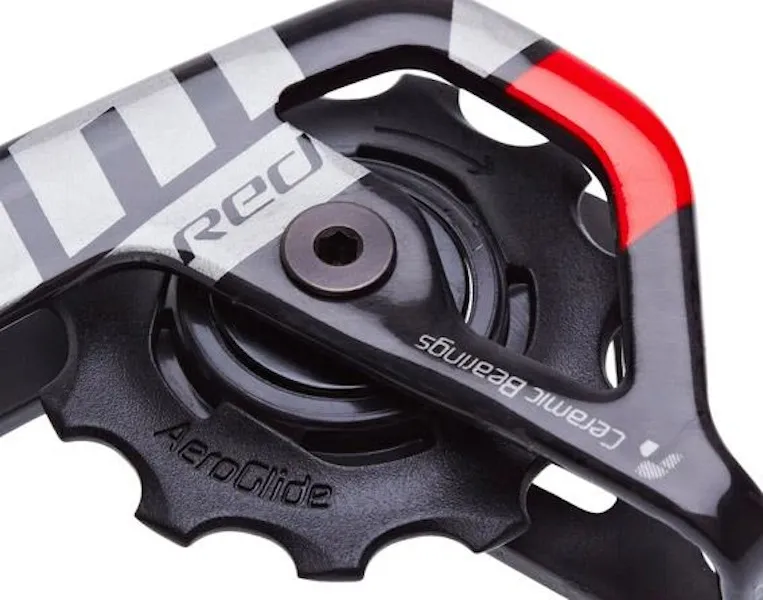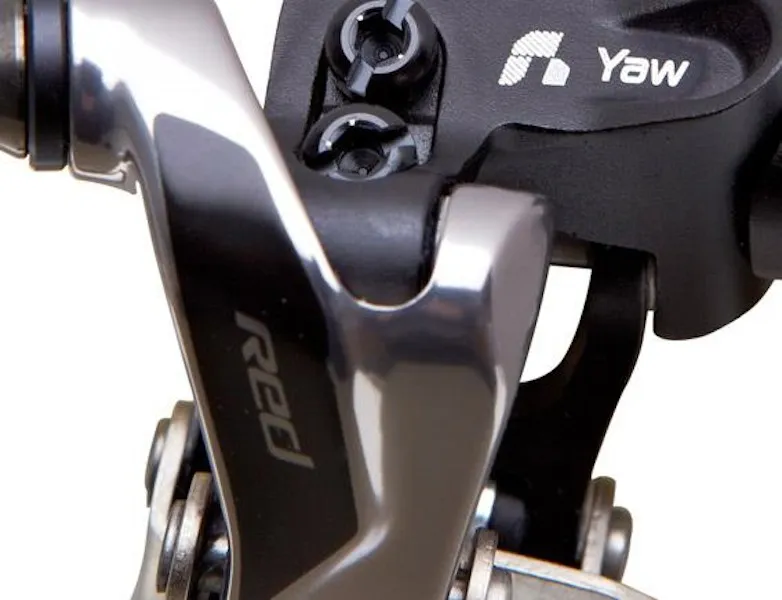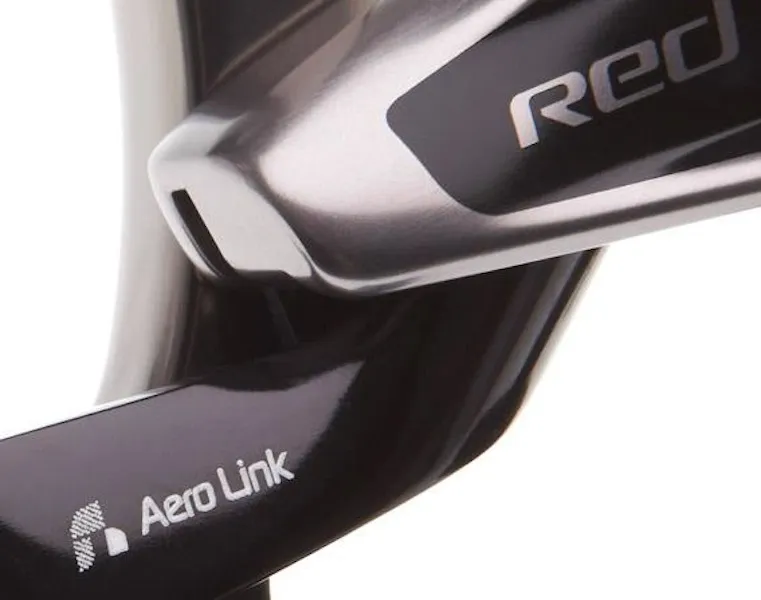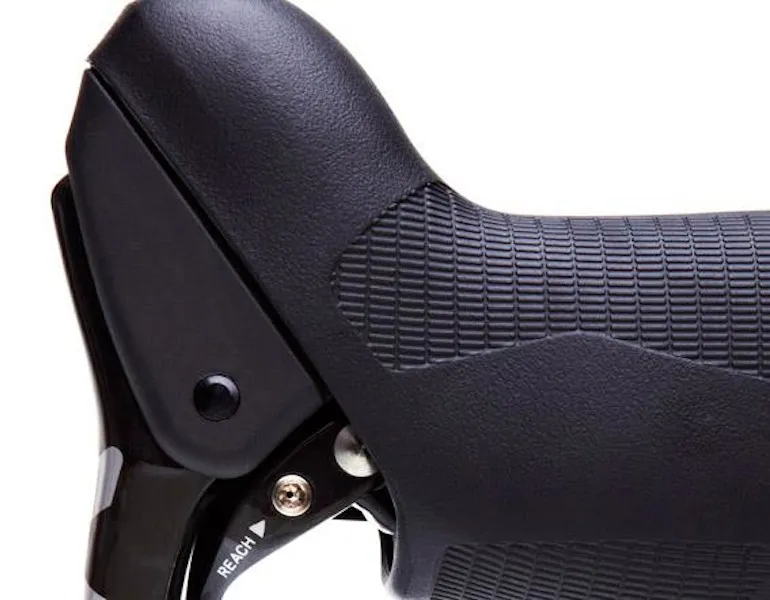SRAM had touted a slow, week-long release of six more teaser images of their upcoming Red revamp on Twitter. However, all six pictures were inadvertently leaked for a few minutes on day 1 of the campaign, and in response, SRAM have now officially released those images along with the trademarked names for the technologies we described after inspecting the photos yesterday, 19 December.
Quieter running pulleys rotating on ceramic bearings
The outer edge of SRAM's new 'AeroGlide' derailleur pulleys will be coated with some sort of polymer to decrease drivetrain noise – a technique Campagnolo have used very effectively on their groups. Like the front shifting, drivetrain noise has been one of the chief complaints with the existing Red group so little changes like this could go a long way.

The revamped SRAM Red rear derailleur pulley teeth get a soft polymer coating for reduced noise. Hybrid ceramic bearings will come standard, too, along with what look to be aluminum bolts
The new pulleys will rotate on hybrid ceramic bearings inside of a carbon fiber cage like before, and it looks like SRAM will shave even more grams by going with aluminum rather than titanium pulley bolts.
XG-1090 cassette is just like XX, only smaller
As has already been widely reported here and elsewhere, the new Red cassette will essentially be a downsized XX piece with nearly identical construction. The bulk of the cassette will be milled from a single piece of steel (think of it as a hollow cone) with heaps of cutouts to reduce weight and, hopefully, noise, plus an aluminum innermost cog that's pressed into place.
What is surprising, however, is the black band that's set into the trough at the bottom right corner of the image – something SRAM calls 'StealthRing'. Based on how SRAM have treated the pulleys, this (apparently soft polymer) band is another mechanism by which the company are seeking to reduce drivetrain noise, which likely also means there may be one embedded in between each pair of cogs throughout the cassette. Between this feature and the coated pulleys, we're expecting a noticeable drop in drivetrain noise once we get to ride the new setup in February.
Hidden fifth chainring bolt will thread directly into crankarm
SRAM have integrated something they're calling 'Exogram' into the new carbon fiber crankarms. What that means at this point is mostly conjecture, but at first glance, it appears it might refer to the external rib running along the edge of the arm. We do know, however, that these cranks will use a proper hollow carbon construction with no internal aluminum spine so it's virtually guaranteed to be much lighter than the current version.
The way the chainrings are attached is also interesting. As we reported earlier, the new Red cranks will feature a hidden fifth arm and it's now confirmed that that chainring bolt will thread directly into the crankarm itself. We've also confirmed the new Red crank will retain the proven GXP spline interface.
It's 'Yaw', not yaw
It looks like we were spot-on with our earlier assessment on the purpose of the front derailleur's non-parallel pivot placement and now we have a label to go along with the feature: Yaw (which is apparently not to be confused with 'yaw').

The redesigned SRAM Red front derailleur features non-parallel pivot pins that will allow the cage to automatically adjust its angle (hence the 'Yaw' moniker) depending on chainring position for reduced cage rub
Aligning the pivots in this manner will allow the front derailleur cage to adjust its angle depending on chainring position for decreased chain rub; in other words, the rear edge of the cage will point more toward the centerline of the bike when in the big ring and more inline or perhaps slightly outward when the derailleur is set over the inner chainring. The new aluminum limit adjust screws are also worth noting, as is the generally more hogged-out appearance of the main body.
Textured upper and lower DoubleTap hood surfaces
The new 'ErgoDynamic' DoubleTap lever hoods will be textured on both the upper and lower surfaces to foster a more secure grip and the reach adjustment for the shift paddle will be much easier to access than before – and with a standard Allen wrench; 2.5mm, we reckon.
It appears that while the lever body's upper bump doesn't tilt inward as we were originally told by our sources, it does look like it has grown in size slightly to give your hands more to hang on to when you're stretched out with elbows dipped. However, if that's correct, that also means the new hoods won't retrofit to older DoubleTap bodies.
Single pivot layout, dual pivot power
Finally, there's that mysterious 'Aero Link' image. SRAM have insisted there's no disc brake caliper to go with the initial Red release and while that telltale slot at the left of the frame looks analogous to what's typically cut into a caliper body, closer examination and comparison with the teaser video SRAM released earlier this month says we're instead looking at a portion of the new cam-actuated rim brake caliper. Disc brakes are still coming – eventually – but this isn't what you're looking at here.

Sorry, folks, you're not looking at a new Red disc brake caliper. This is the leverage-enhancing link on the new Red rim brake caliper
Unable to load media
You don't believe us? Take a closer look at the teaser video SRAM released earlier this month
SRAM delving more into electronics – but what for?
Finally, an interesting tidbit on which to speculate: SRAM recently posted a job listing for an Electrical Engineer – Embedded System Design. The position is located at their headquarters in Chicago, Illinois and the specific job responsibilities listed include "wireless battery-powered embedded systems", "microcontroller-based firmware" and "prototype circuit boards".
Interested candidates should also have a BS degree in electrical engineering, experience in "designing and debugging low power embedded systems and MCUs", "wireless communication protocols" and "strain gages, accelerometers, and hall effect sensors".
Before you jump to the conclusion of an electronic group, keep in mind that nearly all of this stuff pertains to modern-day power meters, too. SRAM road media and PR manager Michael Zellmann had no comment on the job posting so at this point it's anyone's guess to what exactly this refers and SRAM have made it clear that no technologies are off the table when it comes to future product development.
That all being said, the wireless aspect of this listing suggests to us that it isn't related to an electronic group and hall effect sensors are typically used in rotating bits. Our guess? SRAM's recent acquisition of Quarq is just the tip of the company's power meter iceberg and there may be more options coming in the future including a possible hub and pedals.



